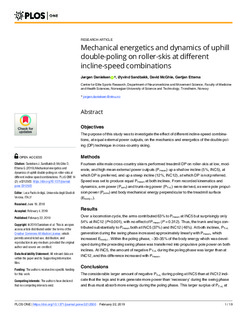| dc.description.abstract | Objectives
The purpose of this study was to investigate the effect of different incline-speed combinations, at equal external power outputs, on the mechanics and energetics of the double-poling (DP) technique in cross-country skiing.
Methods
Fourteen elite male cross-country skiers performed treadmill DP on roller-skis at low, moderate, and high mean external power outputs (Pmean) up a shallow incline (5%, INC5), at which DP is preferred, and up a steep incline (12%, INC12), at which DP is not preferred. Speed was set to produce equal Pmean at both inclines. From recorded kinematics and dynamics, arm power (Parm) and trunk+leg power (PT+L) were derived, as were pole propulsion power (Ppole) and body mechanical energy perpendicular to the treadmill surface (Ebody⊥).
Results
Over a locomotion cycle, the arms contributed 63% to Pmean at INC5 but surprisingly only 54% at INC12 (P<0.001), with no effect of Pmean (P = 0.312). Thus, the trunk and legs contributed substantially to Pmean both at INC5 (37%) and INC12 (46%). At both inclines, PT+L generation during the swing phase increased approximately linearly with Pmean, which increased Ebody⊥. Within the poling phase, ~30–35% of the body energy which was developed during the preceding swing phase was transferred into propulsive pole power on both inclines. At INC5, the amount of negative PT+L during the poling phase was larger than at INC12, and this difference increased with Pmean.
Conclusions
The considerable larger amount of negative PT+L during poling at INC5 than at INC12 indicate that the legs and trunk generate more power than ‘necessary’ during the swing phase and thus must absorb more energy during the poling phase. This larger surplus of PT+L at INC5 seems necessary for positioning the body and poles so that high Parm generation can occur in a short time. At INC12, less Parm is generated, probably due to less advantageous working conditions for the arms, related to body and pole positioning. These incline differences seem linked to shorter swing and longer poling times during steep uphill DP, which are due to the increased influence of gravity and slower speed at steep inclines. | nb_NO |

